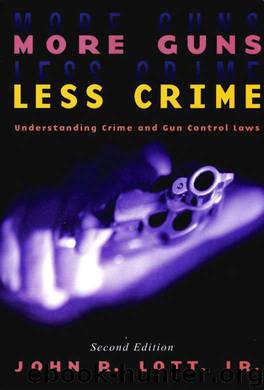More Guns Less Crime by John R. Lott Jr

Author:John R. Lott Jr
Language: eng
Format: epub
Tags: gun control; second amendment; guns; crime; violence
pS,^
^DB|q si jBqi uonBjrtdod s ( A^urto3 b jo axfejuaDiad aqi qjiA\ Xjba sa\b| un2puBq-pa|B3DUOD XiBuopaiDsipuou uiojj 3UIU3 ui aSuBqD aqi saop A\opj g^ airtSij
sejjoBoieo euijj>iuo|0|A
(Z'ZC) 8UORB|A9p PJBPU8)6 OM)
snjd jpsjq si jBifl uogBindod ubow Q
(CZ) uoRBiAep pjBpueje euo sn|d )psiq s\ jeifl uogeindod ueew |J
(88) >p8|q 8] jeifl uoRBindod ueeyy
>pB|q si ibuj uoiVBindod useifl Z/l I
p*E&/*WW edm »p« W
£8T /anooiua
tend to benefit the most from the passage of right-to-carry laws. Taken together, these results indicate that legislators should be sensitive not only to the costs of running the permitting program, but also to how the rules affect the number and types of people who get permits. Focusing only on setting fees to recoup the costs of the permitting system will end up being financially short sighted.
How Sensitive Are the Results to Different Specifications?
While I have tried to control for all sorts of factors that might explain changes in crime over time, it is indeed possible to get overzealous and account for too many variables. Including variables that do not really affect crime can actually create problems similar to excluding factors that should be included. Take a simple example of explaining how the stock market, say the Dow Jones industrials, changes over time. Obvious variables to include would be the interest rate and the expected growth in the economy, but many other variables—many of dubious importance— could possibly also be included. The problem arises when such variables are correlated to changes in stock prices merely by chance. An extreme case would be including the prices of various grocery store products. A store might sell thousands of items, and one—say, the price of peanut butter—might happen to be highly correlated with the stock prices over the particular period examined. We know that peanut butter has little to do with explaining overall stock prices, but if it just accidentally happens to move up and down with the movements in the stock market, other variables (like the interest rate) may no longer prove to be statistically significant.
There are ways to protect against this "dubious variable" problem. One is to expand the sample period. If no true causal relationship exists between the two variables, the probability that this coincidence will continue to occur during future years is low. And this is exactly what I have done as more data have become available: first by looking at data through 1992, then extending them to 1994, and now up until 1996. Another approach guarding against the "dubious variable" problem is to replicate the same test in many different places. Again, this is exactly what I have done here: I have studied the impact of right-to-carry laws in different states at different times. As charged by many a critic, it is still conceivable that some other factor just happened to occur also when an individual state passed the law, but the probability of mere coincidence falls as the experiences of more and more states are examined. It is also possible that
EPILOGUE/ 185
adding variables that don't belong can cause you to get a more significant result for other factors than is warranted.
Download
This site does not store any files on its server. We only index and link to content provided by other sites. Please contact the content providers to delete copyright contents if any and email us, we'll remove relevant links or contents immediately.
| Anthropology | Archaeology |
| Philosophy | Politics & Government |
| Social Sciences | Sociology |
| Women's Studies |
Cecilia; Or, Memoirs of an Heiress — Volume 1 by Fanny Burney(31341)
Cecilia; Or, Memoirs of an Heiress — Volume 3 by Fanny Burney(30938)
Cecilia; Or, Memoirs of an Heiress — Volume 2 by Fanny Burney(30896)
The Great Music City by Andrea Baker(21472)
We're Going to Need More Wine by Gabrielle Union(18080)
Bombshells: Glamour Girls of a Lifetime by Sullivan Steve(13117)
Pimp by Iceberg Slim(12939)
All the Missing Girls by Megan Miranda(12761)
Fifty Shades Freed by E L James(12453)
Talking to Strangers by Malcolm Gladwell(11898)
Norse Mythology by Gaiman Neil(11893)
Crazy Rich Asians by Kevin Kwan(8357)
Mindhunter: Inside the FBI's Elite Serial Crime Unit by John E. Douglas & Mark Olshaker(7844)
The Lost Art of Listening by Michael P. Nichols(6480)
Enlightenment Now: The Case for Reason, Science, Humanism, and Progress by Steven Pinker(6411)
Bad Blood by John Carreyrou(5778)
The Four Agreements by Don Miguel Ruiz(5519)
Weapons of Math Destruction by Cathy O'Neil(5045)
We Need to Talk by Celeste Headlee(4876)
